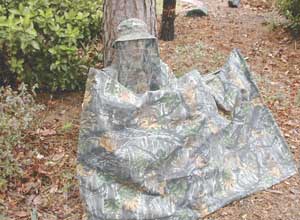
About 30 years ago, my father hauled me out of bed on Christmas morning for a plane ride to south Texas to duck hunt with an uncle who was working for NASA.He was an engineer, the designer of a lot of the systems that went on the Mercury and Gemini projects, so I should have figured that his proficient tinkering would have been extended to his first love: waterfowl hunting.
The first morning, we slogged down four miles of levees between rice fields to a marshy area full of little potholes where big puddle ducks like mallards, black ducks and pintails were subject to pitch in and set a spell, even on bluebird days.
My father and uncle kept talking about the blind, but when we got to our pothole of choice, I didn’t see any kind of blind I expected — no box dug in the wet soil or sticking out of the reeds. And I know we hadn’t carried our blind in — at least not the kind of blind I was expecting. It was too far to walk carrying much more than our shotguns.
My dad waded out and set the half-dozen magnum black duck and mallard decoys, while my uncle went about building the “blind.”
Out of the game pouch on the back of his shell vest, he pulled four dowel rods, each about 3-feet long. They appeared to have been colored with a child’s brown crayon. Then, he went back in his vest for a roll of cloth that had been dyed brown in somebody’s sink. It was about 3×8 feet, and into four long pockets that had been sewn along the seams, he slid the dowel rods, spread the cloth, then jammed the dowels into the wet floor of the marsh.
He took out a pair of small brush clippers and came back with an armful of reeds, which he spread out across the face of the brown cloth. That was our blind, and the three of us hunkered down behind it, kneeling in the mud in our hip boots.
If I had any doubts in my teen-aged mind about the quality of our hiding place, they vanished about 5 minutes after legal hunting light when three black ducks dropped in and almost landed on us.
His little portable set-up blind proved to be invaluable over the next four or five days, as we explored distant areas in the marsh, able to set up almost immediately when we came upon a productive looking pond or pothole.
I didn’t think much about those dowel rods or the brown cloth until I started to see portable blinds in the hunting catalogs that show up in my mailbox on a regular basis. They looked a lot fancier than my uncle’s sticks and cloth, some of them being totally enclosed, with metal supporting rods like the kind that hold my son’s Boy Scout tent together.
Then, the light flashed on. I drove my wife to the store one night, to a store where she was going to buy some fabric to make a dress for one of our daughters. I went into the store, and there, within 30 feet of the front door, was a bolt of cloth that didn’t look like anything a lady’s use to make a dress. A camouflage shirt maybe, but not a dress. It was a bolt of old-fashioned woodland green camo fabric.
I put two and two together one morning at daylight when I was cutting brush to throw together a makeshift blind in front of a big pine tree where I was sitting down to yelp plaintively at a turkey gobbler sounding off across the creek. I was cutting yellow pine seedlings, jamming them into the ground in roughly a semicircle around me, trying to put together some cover that would break up my outline, even though I was in full camo from head to toe.
Wouldn’t it be nice, I decided, to have a portable blind like the one my uncle carried into the marsh. Not brown, but in a camo pattern. I could put it around the base of a tree in a half-circle and be basically invisible to an approaching turkey, maybe even able to scratch any itch that came along while the turkey was 75 yards in front, strutting.
The local huge sporting good store had them the next time I looked, but I almost fainted at the price tag. How could they charge that for three plastic stakes and a couple of yards of Mossy Oak?
I remembered the camouflage cloth in fabric store, and a couple of dowel rods I had in my basement shop. Bingo! Instant portable blind.
Here’s how to make one for a shade of the price you’ll pay in the store. Obtain camouflage cloth. I used a sheet about 3-feet tall and 5-feet wide. I sawed 6-foot dowel rods (3/8 to ½ inch) in half and, using a belt sander, shaped points onto one end of each rod.
I had my wife sew what she called “casings” onto each end of the cloth, and she folded another casing into the middle. That gave me three little “sleeves” into which I could slide my sharpened dowel rods. I rolled up the cloth, and the dowels fit nicely into the game bag on my turkey hunting vest. Now, it’s just a matter of finding the right gobbler and the right tree.
And it cost me only dinner at one of the deli where they sell those huge baked potatoes filled with butter and cheese and bacon.
Cheaper than a store-bought blind.




Be the first to comment